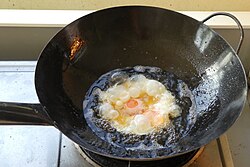Karahi
This article needs additional citations for verification. (October 2018) |
A karahi (/kəˈraɪ/; Bengali: কড়াই, romanized: koṛāi, Hindi: कड़ाही, romanized: kaṛāhī, Marathi: कढई, Urdu: کڑاہی; also kadai, kerahi, karai, kadhi, kadahi, kadhai sarai, or cheena chatti) is a type of thick, circular, and deep cooking pot[1] (similar in shape to a wok) that originated in the Indian subcontinent. It is used in Indian, Afghan, Pakistani, Bangladeshi, and Nepalese cuisines. Traditionally press-formed from mild steel sheet or made of wrought iron, a karahi resembles a wok with steeper sides.[citation needed] Today, they can be made of stainless steel, copper, and nonstick surfaces, both round and flat-bottomed, or of the traditional materials.[citation needed]
History[edit]
Karahi or Kadahi comes from the Prakrit word Kataha, mentioned in Ramayana, Sushruta Samhita. The Karahi vessel is first mentioned in the Vedas as bharjanapatra.[2]
Use[edit]
Karahi serve for the shallow or deep frying of meat, potatoes, sweets, and snacks such as samosa and fish and also for Indian papadums, but are most noted for the simmering of stews or posola,[3][4] which are often named karahi dishes after the utensil.
Karahi dishes[edit]

Stews prepared in a karahi include chicken karahi, beef karahi, mutton karahi (usually made with goat meat, reflecting South Asian usage of the word mutton) and dumba karahi (made with lamb meat) and also karahi paneer (a vegetarian version).[citation needed] Prepared in a reduced tomato and green-chilli base, a karahi is a popular late-night meal in Indian and Pakistani cuisine, usually ordered by the kilogram or half/full karahis and consumed with naan.[citation needed]
An inverted karahi is used to cook rumali rotis.[citation needed]
See also[edit]
References[edit]
- ↑ "Kadhai". Indianfood.about.com. 2009-09-25. Archived from the original on 2011-10-16. Retrieved 2009-11-02.
- ↑ "Full text of "Indian Food Tradition A Historical Companion Achaya K. T."". archive.org. Retrieved 2019-01-30.
- ↑ Promodini Varma, Dheeraj Paul Indian Menu Planner Introduction Roli Books Private Limited, 1995 ISBN 81-7437-018-8, ISBN 978-81-7437-018-1. 192 pages
- ↑ J. Inder Singh Kalra Prashad Cooking with Indian Masters page 28

